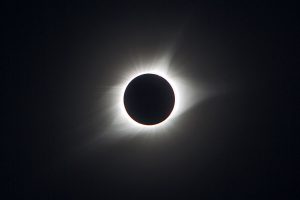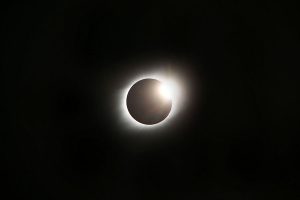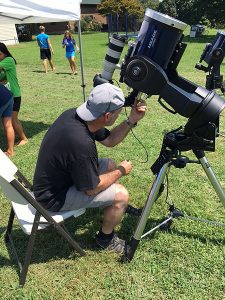The Total Eclipse of the Sun
It is difficult to convey in words, or even in photos, what it is like to experience a total eclipse of the sun. For those who have entered the narrow zone of totality during a solar eclipse, it is a strange and inspiring moment. In the aftermath, I am left with feelings of wonder and awe at this spectacle that continues to touch the earth and captivate human beings everywhere.
For more than two years, my wife Sharon and I planned this trip to eastern Tennessee to see the great American Eclipse of 2017. We were able to join up with our Middle School Science Teacher, Kate Alvarado and her two children, together with one of our former Math Teachers, Chris Pate. At the rural home of one of Kate’s college friends, we were able to enjoy a wide-open panorama among gently rolling farm land and clear open skies.

On the morning of the eclipse we gathered to set up telescopes, binoculars and cameras, all equipped with solar filtration. A few hours later, the big event started. As the sun gradually disappeared behind the moon’s black silhouette, the sky darkened and everything took on a strange clarity of light. The temperature dropped noticeably, insects started to chirp, birds began to roost, and bright stars and planets appeared high overhead. Beneath trees, the dappled light of the crescent sun danced in hundreds of small crescents on the ground. Then, suddenly, from the west, a giant shadow of darkness rapidly approached and twilight descended all around us. More stars appeared and the warm color of sunset settled just above the horizon in all directions. In those final seconds before totality, the last glint of sunlight sparkled like a diamond ring then faded into shimmering beads of light until the sun completely disappeared. At that moment, a radiant halo of light encircled the moon as the sun’s hot corona spread out in long ghostly streamers of ionized gas glowing against the darkened sky. At places around the edge of the moon, the warm ruby glow of the sun’s surface could be seen peeking out with an occasional prominence looping outward in deep reddish purple.
For two and a half minutes we were spell bound by the eerie darkness, the arresting vision of the sun’s transformation into a dark black hole, all crowned by a strange radiance we normally never see. And then in reverse order the shimmering beads reappeared, the diamond sparkled again, and with the smallest emergence of the sun’s bright crescent, sunlight exploded upon the earth once again and everything gradually returned to normal.

Scientists tell us that the sun is 390 times larger than the moon, but it is also 390 times farther away. Every eighteen months or so they align perfectly so that the moon’s shadow passes over the earth, and those in the path of that shadow see a solar eclipse. This is often described as one of the great coincidences of our solar system. Astronomers also tell us that there are 147 moons in our solar system. But ours is the only one with the exact size and distance to perfectly match the sun and produce the kind of solar eclipse we experience. If our moon was any smaller the sky would not turn dark, and if it was any larger, we would never see that brilliant corona. For many, it is a source of wonder, that the one place where these amazing eclipses occur, is the one place where there are observers to see them.
In one of his humorous harangues about “Life Below the Beltway,” Washington Post contributor, Gene Weingarten, once admitted, “I am a devout atheist but can’t explain why the moon is exactly the right size, and gets positioned so precisely between the earth and the sun, that total solar eclipses are perfect. It bothers me.” (The Washington Post, Sunday, March 8, 2009). And so it is that this extraordinary event has been witnessed by our planet throughout history. But the nature of that privilege extends even farther than most imagine.
The precise relationship of size and distance we witness during an eclipse is a result of our finely-tuned position in the solar system. Peter Raimondi, an ecologist at the University of California, Santa Cruz, says that the size of our moon produces ocean tides that influence the very existence of life on our planet. “Without our moon, our marine environment would be much less rich in terms of species diversity” (Scientific American, April 21, 2009). In fact, some scientists believe that our disproportionately large moon, unlike Venus and Mars, produces gravitational influence that helps ensure that earth’s spin, axis and climate remain stable.
But it is our distance from the sun that defines our unique place in the solar system and perhaps within the entire cosmos. Any closer, and our oceans would be burned off into hot atmospheric gas, like Venus. Any father, and they would be locked up in frozen ice caps, like Mars. Only earth is the right distance from the sun to be covered with liquid oceans capable of sustaining carbon-based terrestrial life.

So when I look at a solar eclipse, I see more than a stunning visual phenomenon. I see what appears to be only the tip of an iceberg, a mountain of finely-tuned qualities defining our privileged place in the universe. Of course, the search is on to find other planets that bear similar qualities needed for terrestrial life. And indeed, we have found other distant solar systems, but none with a planet that matches the blue, living, watery home we call earth.
As a Christian educator, I am reminded that God reveals His truth to us in two ways: through the general revelation of His natural world and through the special revelation of His written word. Psalm 19 encapsulates this for us beautifully. “The heavens declare the glory of God, and the sky above proclaims his handiwork.” (Ps. 19:1). There are no words, and yet the message of God’s existence and power is heard everywhere. As Paul Tripp has said, “It’s hard to get out of bed in the morning without running into God” (Your Christian School: A Culture of Grace, 2009). But God does more than tell us of His existence. He sets forth a plan for our lives to bring us into fellowship with Himself. The last half of Psalm 19 describes this. His word is perfect, sure, right, pure and true, more desirable than gold, and sweeter than honey (Ps. 19: 7-11). Through words, God has given us His great plan of redemption by which He meets our deepest need and satisfies our deepest desire – to know Him.
I’ve heard the word “coincidence” repeatedly over the past month. But somehow that word feels pallid and weak against the brilliance of what I saw last week. The common explanations of “coincidental” size, distance, speed, trajectory, and alignment are thoroughly unsatisfying to me. It is as though every eighteen months or so when we see a solar eclipse somewhere on the earth, God reminds us once again of the undeniable and special design of His world. I am left with a deep sense of gratitude for the creative imagination of our God who so powerfully and generously reveals to us that He is there, He is not silent, and He is still present in this world.
Written by our Head of School, Mr. Stephen E. Danish